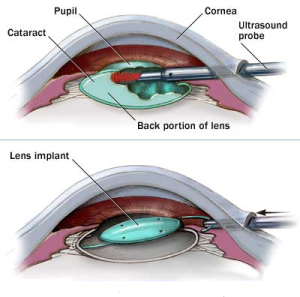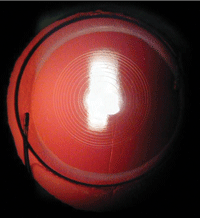Last time around on Eye to the Future, we discussed in detail What is a Cataract?. This time around we will be addressing what we do about it! Mainly, cataract surgery.
As discussed before, it is common for clouding of the human lens to be present on most individuals over the age of 50; this condition is called a cataract. However, it typically takes a long time (as in over a decade or more) to reach the point where the human lens has clouded enough to require surgical intervention. It is possible to tweak glasses prescriptions, improve lighting, and use anti-reflective coatings on the lenses to cut down on the symptoms associated with cataracts. However, the best method for addressing this condition head-on is through cataract surgery.
 Cataract surgery permanently removes the clouded cataract and replaces our human lens with a crystal clear, man-made lens. Above is an advanced cataract on the left and the same eye after the cataract is removed and the implant positioned. It’s not hard to imagine the improvement this will have on vision. And the way in which this surgery has evolved as well as some newer implant options available is just…. awesome!
Cataract surgery permanently removes the clouded cataract and replaces our human lens with a crystal clear, man-made lens. Above is an advanced cataract on the left and the same eye after the cataract is removed and the implant positioned. It’s not hard to imagine the improvement this will have on vision. And the way in which this surgery has evolved as well as some newer implant options available is just…. awesome!
It should also be clearly stated that there have been no peer reviewed, credible studies to suggest, support, or confirm that any other treatment exists (supplements, vitamins, medications, etc) to improve the symptoms or severity of cataracts – other than cataract surgery.
Cataract Surgery Procedure
 Cataract surgery is an outpatient procedure performed under general anesthesia which means you are awake but sedated. Cataract surgery is done one eye at a time (separated by one or more weeks of healing). During this procedure a cataract surgeon will make two small incisions in the cornea to allow instruments to be inserted into the eye. The crystalline lens sits in a thin membranous bag and to get to the lens, the front surface of the membranous bag is removed. In the past, the lens was removed whole, requiring a very large incision and a long recovery time. Nowadays, the surgeon uses an ultrasound probe to break up and remove the lens inside the eye. Now that the clouded lens is removed, a man made lens is put back in it in place allowing clear vision once again. The incisions are self-healing and no stitches are required. The entire surgery takes about 10 minutes.
Cataract surgery is an outpatient procedure performed under general anesthesia which means you are awake but sedated. Cataract surgery is done one eye at a time (separated by one or more weeks of healing). During this procedure a cataract surgeon will make two small incisions in the cornea to allow instruments to be inserted into the eye. The crystalline lens sits in a thin membranous bag and to get to the lens, the front surface of the membranous bag is removed. In the past, the lens was removed whole, requiring a very large incision and a long recovery time. Nowadays, the surgeon uses an ultrasound probe to break up and remove the lens inside the eye. Now that the clouded lens is removed, a man made lens is put back in it in place allowing clear vision once again. The incisions are self-healing and no stitches are required. The entire surgery takes about 10 minutes.
Below is a great video of a routine cataract surgery as well as easy to understand narration of the steps.
Disclaimer for the squeamish: There is little to no blood, but this is a video of a surgery.
Cataract Surgery Risks, Recovery, and Rewards
All surgeries should be taken seriously, however, cataract surgery is the most frequently performed outpatient procedure in the United States with a very low risk for permanent vision complications (only about 1-2%). The standard post-operative for monitoring is usually one month. During this post-operative period, eye drops are used frequently to prevent infection and inflammatory complications and follow up visits are required in order to check on the healing process.
Recovery is usually rapid with substantial vision improvement within a few days of the operation. A large study recently found that 95% of adults were satisfied with their vision and quality of life after cataract surgery. Furthermore, having cataract surgery also decreased the risk of car accidents by 2.5 times and serious falls and fractures by 34%.
Cataract Surgery Implants
 When the cataract is removed from the eye, there is an opportunity for the surgeon to put any powered lens back in its place. Measurements are taken before the surgery to measure what powered lens is needed to correct for any underlying prescription like nearsighted, farsighted, or astigmatism. A lens is then chosen to correct for your individualized glasses prescription which results in most individuals being far less reliance on distance glasses after cataract surgery.
When the cataract is removed from the eye, there is an opportunity for the surgeon to put any powered lens back in its place. Measurements are taken before the surgery to measure what powered lens is needed to correct for any underlying prescription like nearsighted, farsighted, or astigmatism. A lens is then chosen to correct for your individualized glasses prescription which results in most individuals being far less reliance on distance glasses after cataract surgery.
Even more exciting is that in the past decade, more advanced lens implants have come to market like the Restor Lens at right. In addition to making distance vision clear, these lenses can also focus for up close reading tasks as well! While not a perfect system, this type of lens up-grade can actually free patients from all glasses for most activities!!
All surgeries can be stressful, scary, and uncertain times, but at Precision Family Eye Care we see cataract surgery as an opportunity and only work with the very best surgeons in our area to give our patients a comfortable experience and a rewarding outcome.
As always, if you have any additional questions. Please feel free to contact us.
– Nick Wolf, OD


